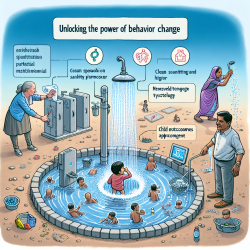Introduction
As a speech-language pathologist dedicated to improving children's outcomes, understanding the nuances of behavior change is crucial. The research article titled "The Integrated Behavioural Model for Water, Sanitation, and Hygiene" provides a comprehensive framework for designing and evaluating behavior change interventions, particularly in infrastructure-restricted settings. This blog will explore how practitioners can apply these insights to enhance their practice and drive positive outcomes for children.
The Integrated Behavioural Model for Water, Sanitation, and Hygiene (IBM-WASH)
The IBM-WASH model synthesizes existing behavioral models and frameworks to address the limitations of previous approaches. It acknowledges three dimensions that influence behavior change: Contextual Factors, Psychosocial Factors, and Technology Factors. These dimensions operate on five levels: structural, community, household, individual, and habitual.
Application in Practice
Practitioners can leverage the IBM-WASH model to design interventions that are both comprehensive and context-specific. Here are some actionable steps:
- Contextual Analysis: Understand the environmental and societal factors that impact behavior change. This includes assessing access to resources, socioeconomic status, and community norms.
- Psychosocial Interventions: Focus on modifying attitudes, beliefs, and social norms. Encourage practices like handwashing by addressing emotional triggers such as disgust and social desirability.
- Technology Integration: Ensure that the technologies used are accessible, user-friendly, and meet the community's needs. For instance, placing handwashing stations in convenient locations can significantly improve usage rates.
Encouraging Further Research
The IBM-WASH model is a valuable tool for practitioners, but it also highlights the need for further research. Understanding the dynamic interplay between the different dimensions and levels can lead to more effective interventions. Practitioners are encouraged to contribute to this body of knowledge by documenting their experiences and outcomes.
Conclusion
By applying the IBM-WASH model, practitioners can create more effective behavior change interventions that lead to sustainable improvements in children's outcomes. The model provides a structured approach to understanding and influencing behavior, making it an invaluable resource for those committed to enhancing child development.
To read the original research paper, please follow this link: The Integrated Behavioural Model for Water, Sanitation, and Hygiene: a systematic review of behavioural models and a framework for designing and evaluating behaviour change interventions in infrastructure-restricted settings.










